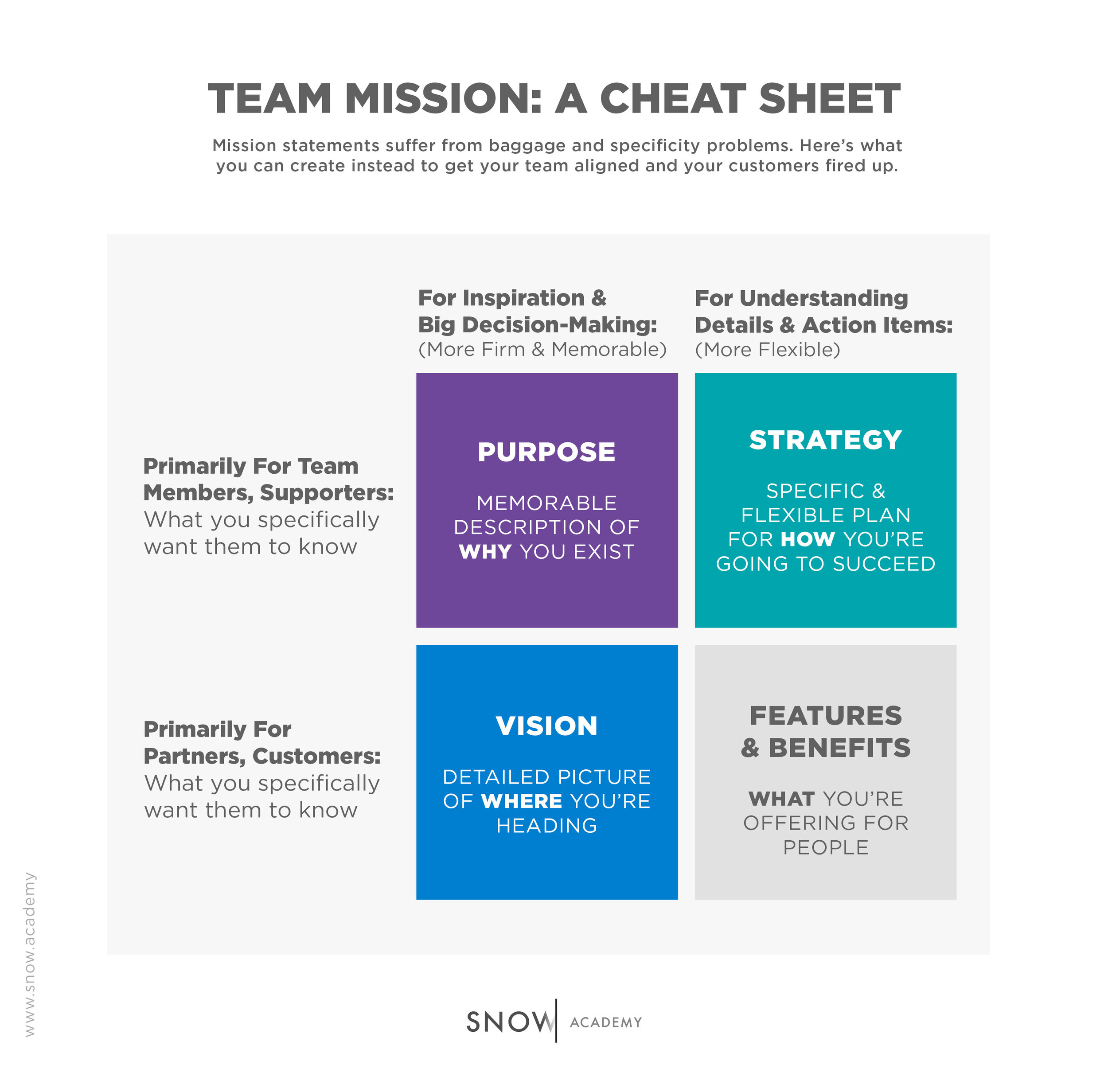5 min read
What Makes A Good Mission Statement? Start With A Good Purpose
![]() Shane Snow
Jan 10, 2023 6:47:46 PM
Shane Snow
Jan 10, 2023 6:47:46 PM

explorations > Teamwork > Purpose
In the early days of the startup company I co-founded in 2010, when my partners and I first discussed the idea of putting together a Mission Statement, we groaned. It was just the three of us at the time, and I remember the conversation going something like this:
"Ugh, most Mission Statements are such B.S."
"Yeah."
"Yeah."
"..."
"...let's do one later."
We were pretty clear on what we were trying to accomplish. And when it was only three of us, we communicated all day long. We were a hive mind. Why did we need a "Statement" to tell us what was up?
But as our company grew, that kind of consensus became more evasive. New employees weren't steeped in what we took for granted. People were asking the same questions about our “mission was” over and over.
So we circled back to the idea of a Mission Statement. And we groaned again.
To us, such a statement would need to be useful or we weren’t going to do it. And that meant it needed to not just state the obvious that every company wanted to do. Make customers successful, make our employees successful, make money for the shareholders blah blah blah. Yeah, everyone wants that.
Unless you're the Suffolk County chapter of MS-13, you can pretty much assume all employees mean to be ethical, responsible, and low-key honest when it comes to padding timesheets and pilfering bathroom supplies. The graphic below is a real-live example of the laundry list Mission Statement in all its convoluted glory:

This is similar in many ways to company values. If the list of things your group “values” just adds up to what every company should do anyway—Integrity! Excellence! Transparency! Diversity!—then what’s the point of making such a list? (I get into this at length in this article here, if you’re interested.)
How do you write a useful mission statement?
-
It has to be concrete
-
It has to be helpful for making decisions at YOUR organization
-
Not so specific that it boxes you in to a particular strategy
-
Easy to remember
When you frame things this way, it becomes clear that a typical mission statement isn’t even the right solution.
(Besides, like too many other terms that have been twisted into buzzword wreckage, “mission statement” simply has too much baggage at this point. One can’t count on two people having the same definition for one, as all the confusing advice out there in the blogosphere makes clear.)
So what then, if not a mission statement?
I’d propose three things instead:
-
Your team and customers need to be clear on and excited about the reason your company exists. I think this one is best framed as your company’s PURPOSE.
-
To want to work with you, your best potential partners will want to have clear and exciting picture of what the world will look like if you’re successful at achieving your purpose. This picture of the future can be called your VISION.
-
When you have that cleared up, you’ll want a plan on how to get to that vision. These details comprise your STRATEGY, and it should be flexible.

Here are a few examples to help make this concrete:
What is a purpose driven company?
A good articulation of a company’s purpose is clear, easy to remember, and exciting. Ideally, this is something more fundamental than just whatever it is your company makes. It should be the dent that you want to make in the world.
Good Example: “Our purpose is to organize the world’s knowledge.”
Good Example: "Our purpose is to help businesses do marketing that people actually appreciate."
Good Example: "Our purpose is to help families have fun together."
-
As you can see, these are all broad and high-minded, and leave enough room to explore different ways to achieve the purpose as the business evolves.
Bad Example: “Our purpose is to build the world’s best search engine.”
-
This may sound good, but what happens when you build the search engine? Does Google just stop there? No. A useful purpose is bigger than just a specific thing you want to make.
Bad Example: "Our purpose is to build a $100mm self-serve content marketing software company."
-
This is neither inspiring to an employee or customer, nor a purpose. It’s a goal with a specific strategy that may not be the right one. (What if your customers end up wanting a managed service instead of self-serve? It would suck to be locked into the how via your Purpose statement.)
Bad Example: "We exist to sell cartoons to TV stations and get royalties from them."
-
This isn't why you exist. This is just what you currently happen to sell. Then suddenly you realize people want something other than cartoons… or someone has the idea to build a theme park… what now? If you do those things, what was the point of the purpose statement? If you stick to the purpose statement and don’t go for those opportunities, you don’t become Disney. Yikes!
A company's strategic vision concerns what success looks like
Once you’re clear on the dent you want to make in the world, it’s useful to articulate what the world looks like when you’ve pulled that off. This gives your team members a filter through which to run decisions. Is this thing we’re about to do going to get us closer to what we’re envisioning?
My favorite way to frame a vision is to start with the sentence, “In the sci-fi future, we will...”
Good Example: “…have catalogued everything on the Internet, and the world will rely on us to help them find whatever information they want.”
-
This shies away from the how while getting more specific about what success looks like.
Good Example: "…have every major brand in the world running on our platform for all their content marketing."
-
This paints a very clear picture of what the world looks like if you succeed.
Good Example: “…have 80% of families around the world regularly engaging with our entertainment properties.”
-
This is a lofty goal, but it’s specific without being prescriptive.
Good Example: "…sell a million hamburgers a day."
-
This one's OK because you can picture exactly what that looks like. You know exactly what you're trying to accomplish, and you have the flexibility to plan accordingly.
Bad Example: "…hit our Q4 revenue numbers."
-
Holy boring! Are you begging your people to decamp for more exciting jobs? This paints a picture, but that picture is pretty beige. You're not going to inspire your people in the long run. Also, Q4 is coming up pretty fast for a Vision. Why not just have a Q4 goal?
Bad Example: "…use a freemium model to onboard 10,000 customers a year."
-
The 10,000 customers thing is a worthy vision, but you don't want to be rigid about how you achieve it. What happens if you learn that freemium doesn't work as well as something else?
A company's strategy stands a better chance of succeeding when you know how to be flexible
Finally, once your team has a great idea of where it’s heading, the whole game (of business) is all about building out a strategy for how to get there, and then executing it.
If your team knows where you want to go and why, but aren’t clear on the current roadmap for getting there, they’ll at best be a pain, and at worst make bad decisions.
Now, that roadmap can change. And should, actually. That’s what great leadership should be about:

If your Vision is good and your Purpose is inspiring, then changing your Strategy from time to time won’t create any panic. It should be cause for celebration.
A lot more celebration, for sure, than the unveiling of a crappy mission statement.

tl;dr
